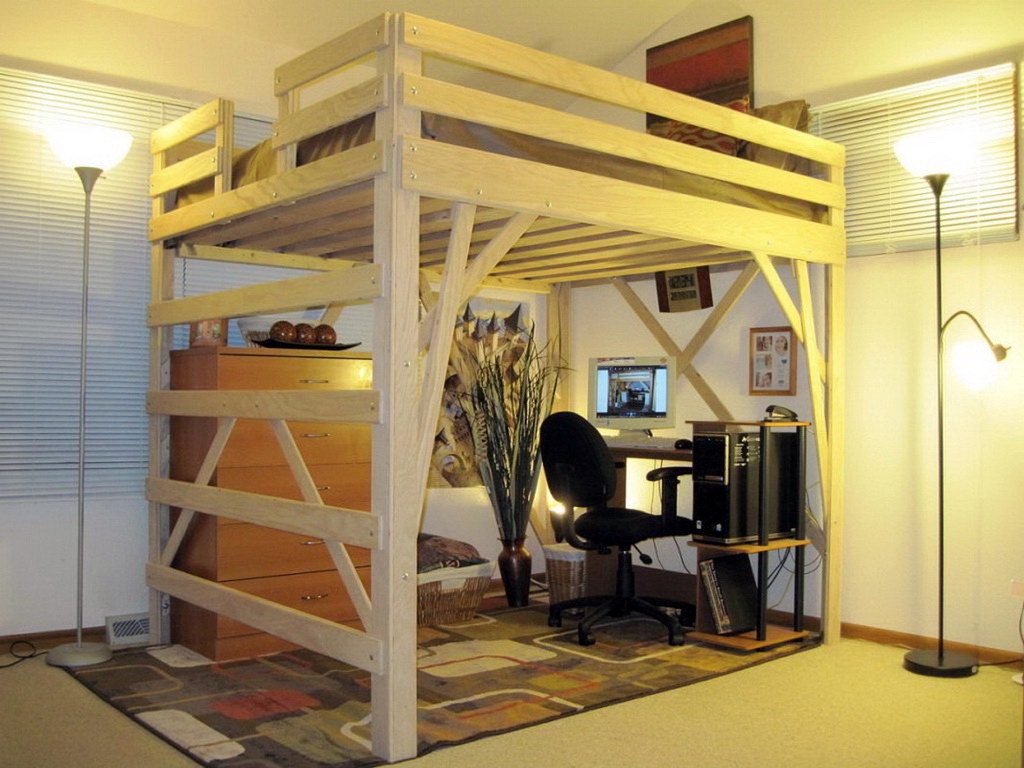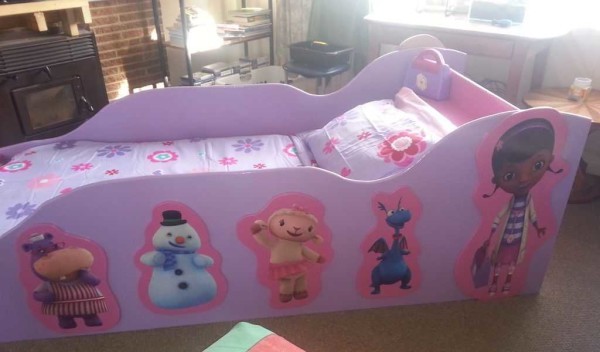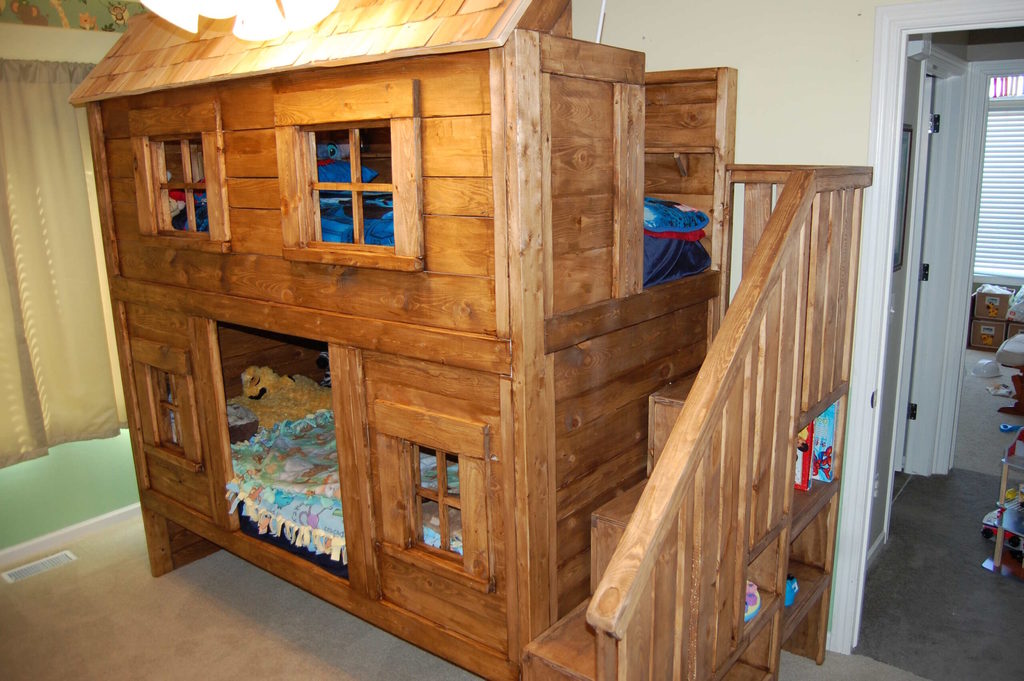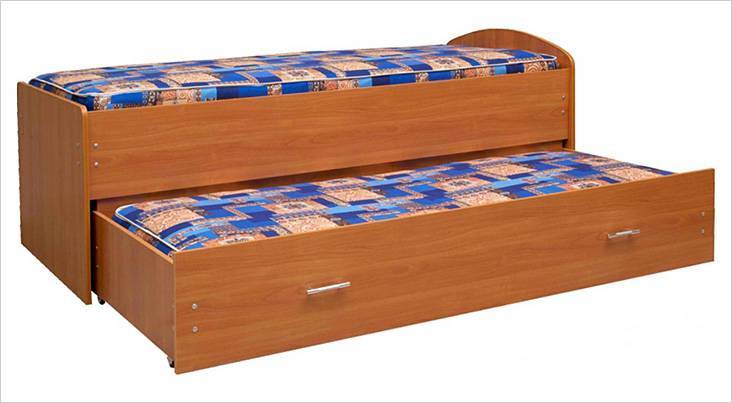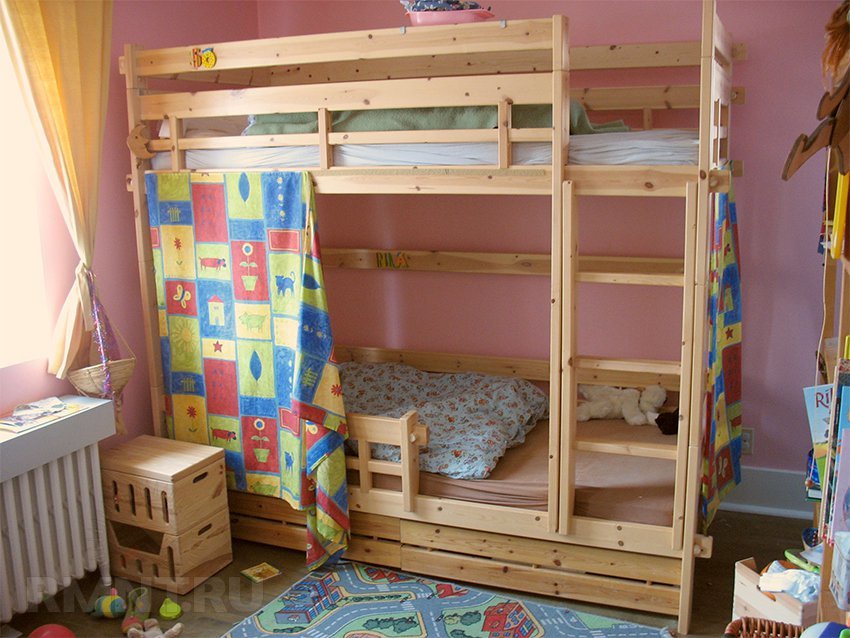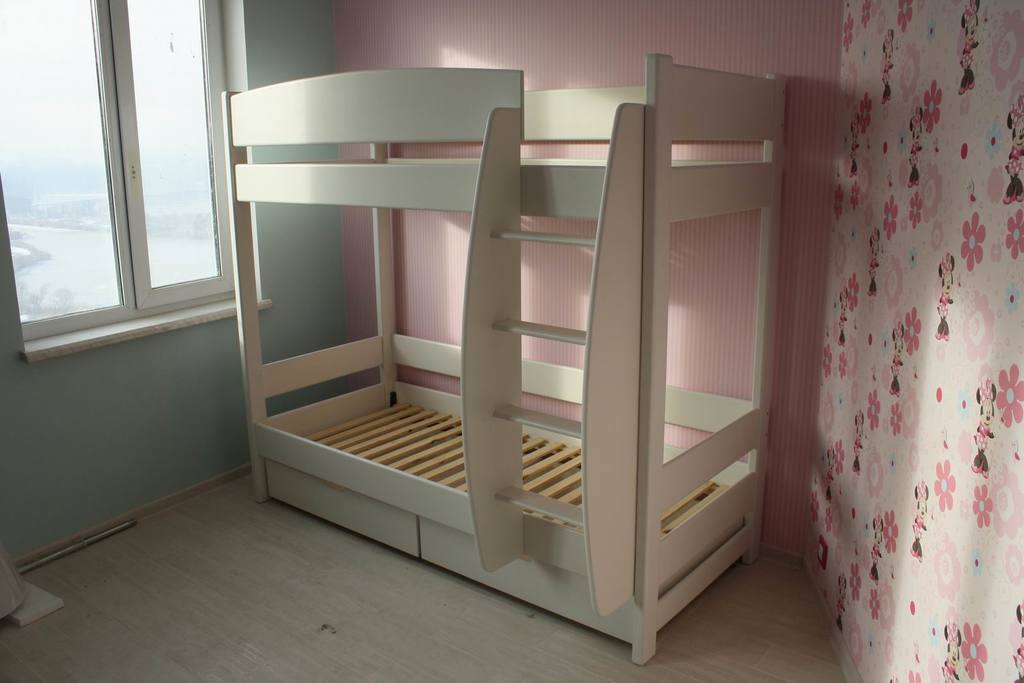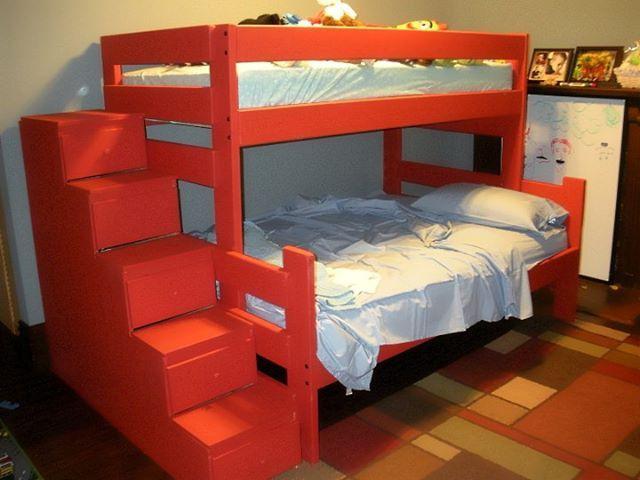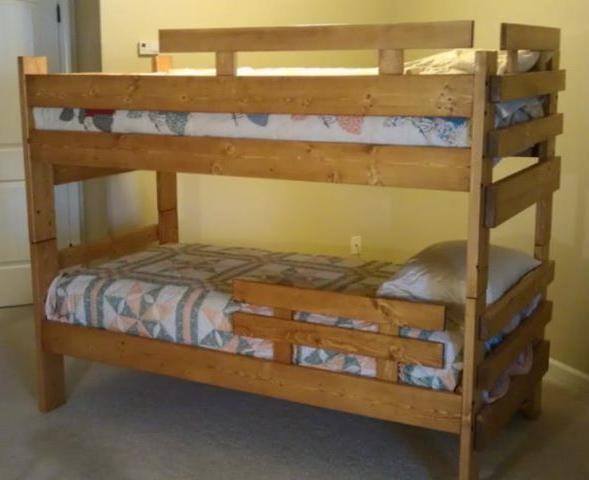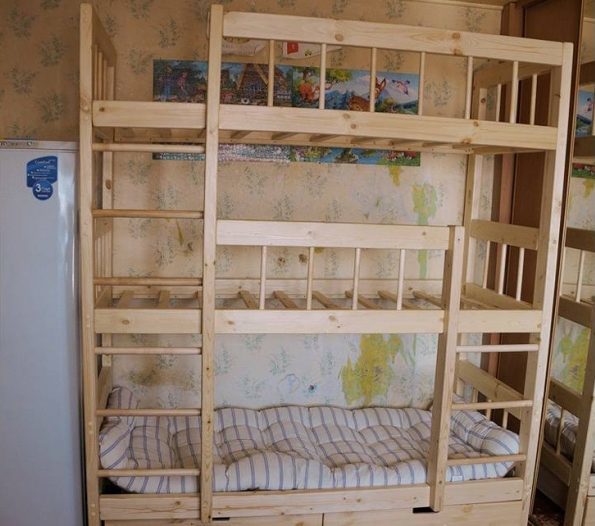Updating the furniture in the children’s bedroom is of particular importance. The normal bed (let alone the DIY Bunk Bed) deserves the most attention – the central element in this room. When choosing new furniture, many questions always arise: what model and material to choose, where to buy, what is the current pricing policy, and much more. We propose to get rid of half of the questions by asking others and make a bed with your own hands.
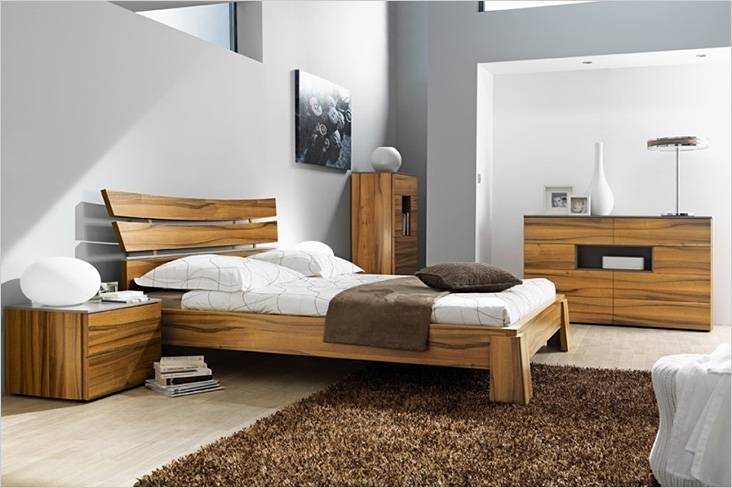
If you want to see more woodworking wizardry — check out our FREE 50 woodworking plans eBook 🙂
Is it worth taking such a step?
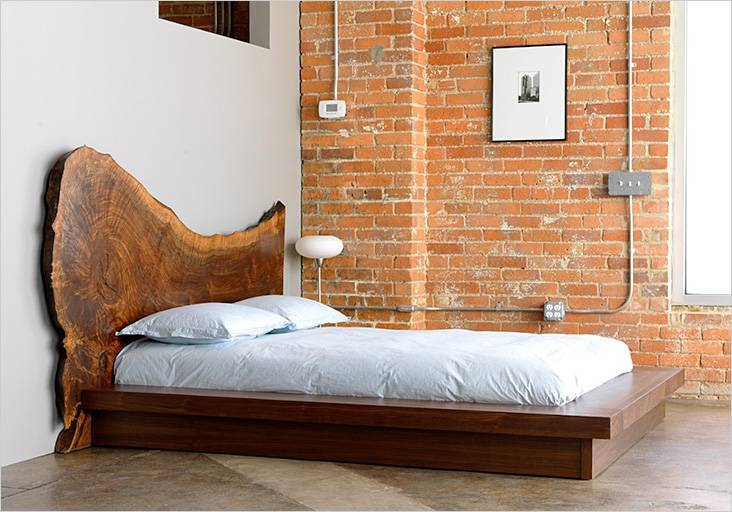
Building a bed is no easy task (let alone a bunk or double-deck bed). It needs to be approached with serious intent, and a lot will have to be planed. In this case, the question arises whether it is worth designing a bed with your own hands. Let’s figure it out together.
Building a bed with your own hands has many ‘pros’, the main of which is savings. Homemade furniture is much cheaper than store-bought ones. Considering that the bed you buy at the retail price will be even higher. And by spending time assembling furniture, you save money that can serve other purposes.
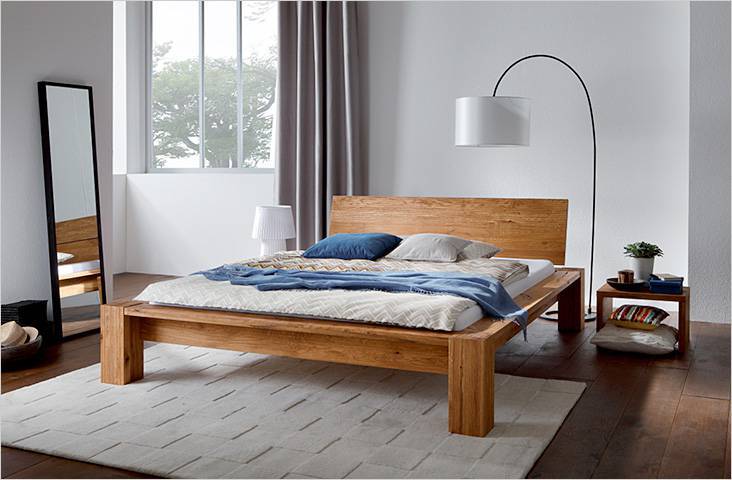
Quality is a big plus. In this case, you can vouch for the quality, as you independently select the material and all the parts for manufacturing. You make the assembly and would not allow hack-work, because you are doing this for your family. This is a huge plus because products on the modern furniture market cannot boast of high quality.
Of course, it would also raise your own self-esteem, because it is very pleasant to see your kids using a bed created with your own hands. And if the bed is intended for younger children, it is even more rewarding.
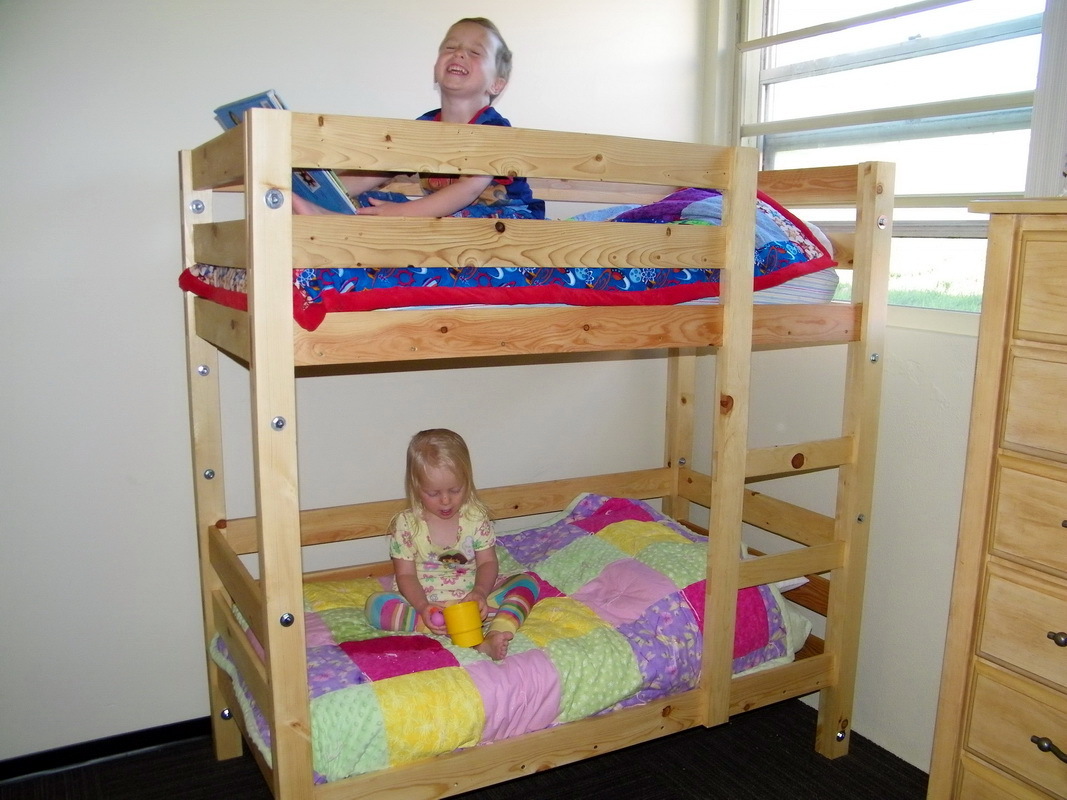
You can embody any idea that comes to mind. There is not always a suitable model in the market. And you are able to create something that will satisfy all your needs.
If you want to see more woodworking wizardry — check out our FREE 50 woodworking plans eBook 🙂
So there is no doubt: you can and should create a bed with your own hands. You will have to work, but you will see that the process is quite simple and will bring great rewards.
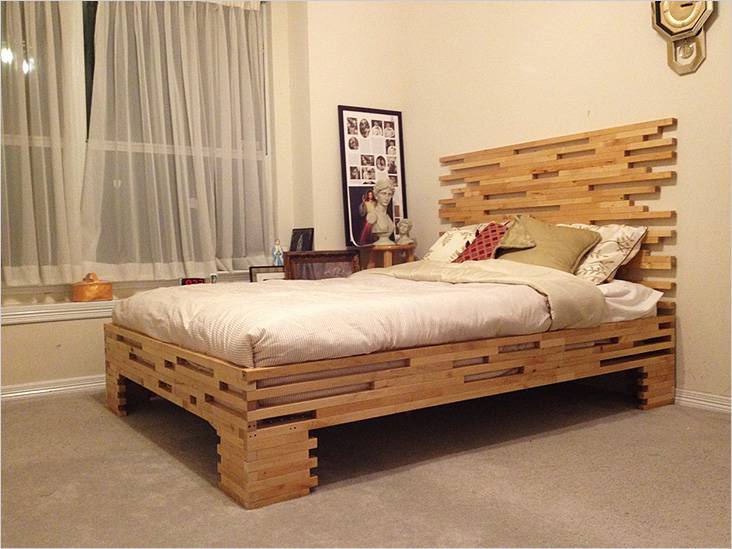
In our opinion, if you like the upper-mentioned design, you might also fancy something else along the lines of a DIY Farmhouse Dining Table or a rustic DIY Picture Frame. Also, a DIY Coffee Table made of un-aligned planks could add a nice touch-up!
Determining the type of our DIY Bunk Bed
In the modern world, there are many models of beds, so it is sometimes difficult to decide which one is suitable. We offer to classify existing ones according to certain criteria.
| Criteria | Types |
|---|---|
| Age | Infant (<3 years old) Middle (3-11 years) Teenager (12+ years) |
| Size | Cradle Single Double Queen-/King- size Bunk bed / double-deck bed |
| Number of tiers (/decks) | One Double-decker Triple-decker |
| Additional storage space | With boxes With shelves With a wardrobe |
| Mechanism type | Fixed (doesn’t move) Transformer Folding With lifting mechanism |
| Headboard type | Soft Solid With gaps High Low etc. |
| Bed material | Wood Metal Wood-based materials Chipboard |
| Shape | Rectangular Round Square In the form of some objects (cars, ships, castles, etc.) |
| Bed support type (base) | Legs Solid |
Now, in accordance with this table, you can choose the bed model that suits you, and make it yourself.
As there are dozens of variations, in this article we will be focusing only on the bunk-bed (double-deck bed) for kids/teenagers (technically, you could extend them to suite adults). In the future, we might make other tutorials — in this case, they would be linked below 🙂
If you want to see more woodworking wizardry — check out our FREE 50 woodworking plans eBook 🙂
What you need to focus on when building a bed
There are several criteria that must be considered in order to create furniture correctly:
- Age and gender. These criteria are of great importance. After all, a bed for a child is significantly different from furniture for a teenager, both in size and in appearance.
- Dimensions of the room. Before making a bed, you need to make measurements of the room, and only in accordance with them make a drawing/blueprint. Also, don’t forget about door-opening-size: in case you building in a different room.
- Personal preferences. Of course, this is an important factor, because you are making a bed for a member of your family, and it should suit their taste.
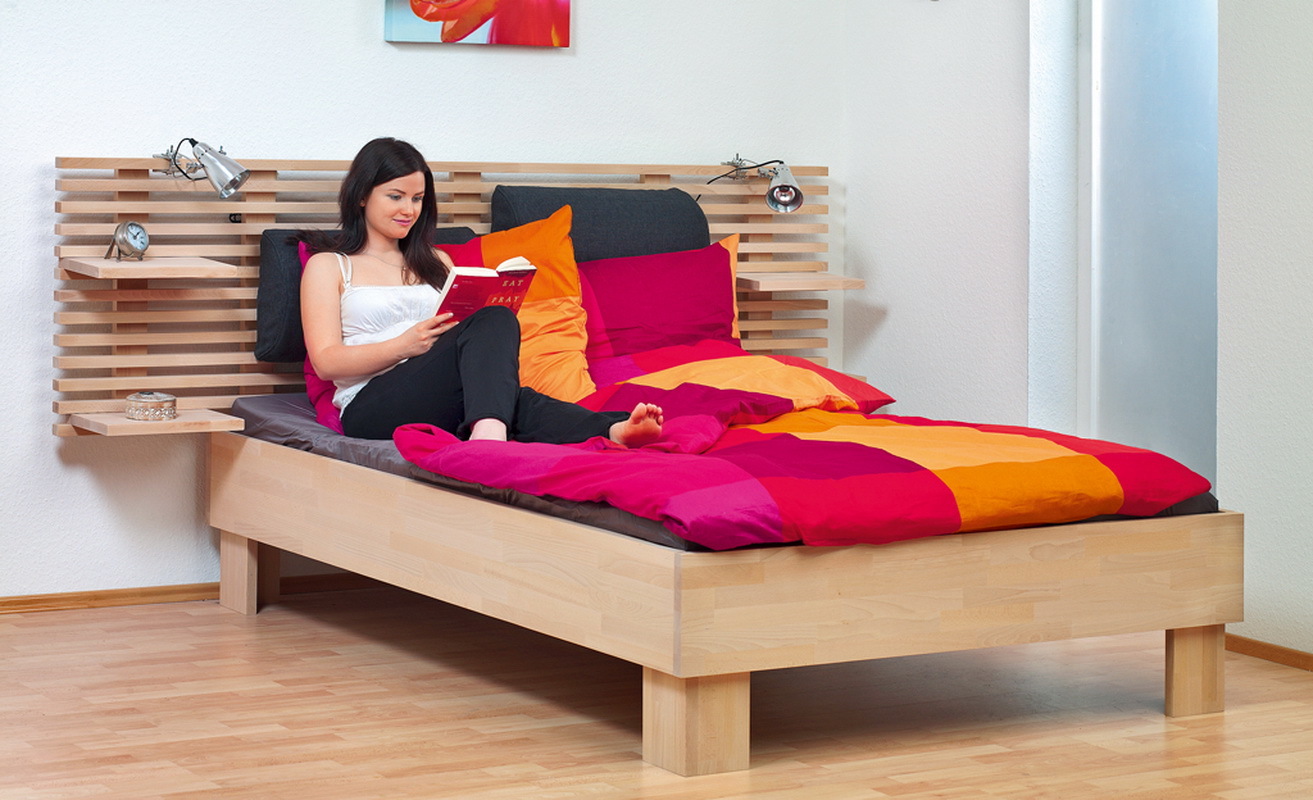
- Budget. To avoid unforeseen situations, it is necessary to immediately calculate the available budget, and draw up a further plan in accordance with the calculations.
Remember, the design process should be fun. Only in this case, you will get a wonderful and reliable result.
We propose to make a DIY Bunk Bed that can be used for two children, teenagers, as well as for two parents and a small child. But first, check out the advantages and disadvantages of this design.
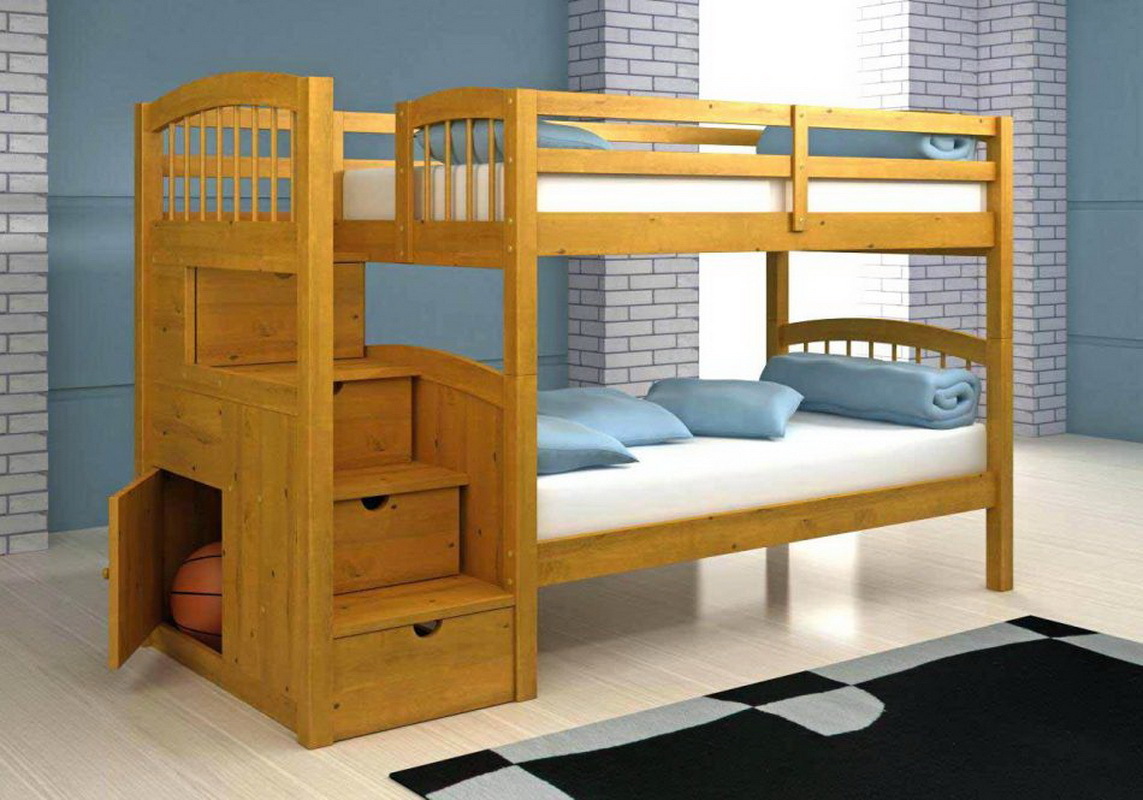
If you want to see more woodworking wizardry — check out our FREE 50 woodworking plans eBook 🙂
Advantages and disadvantages of a bunk bed (pros and cons)
If you doubt the reliability and feasibility of the proposed design, pay attention to its advantages and disadvantages.
The first advantage comes from the reason that worries many parents with more than one kid – space-saving. Multi-berth bunk designs save you the hassle of looking for an extra bed or sofa that takes up precious space. Bunk beds have a number of other advantages.
- Ergonomics. You don’t have to constantly fold and unfold a sofa, or install a fold-out bed. Everything is already here. And the bed-making of such a sleeping place for a child will be much easier – just cover it up.
- Creativity. This design looks unusual, and if you choose an unusual design, the effect will double. For example, skilled craftsmen may think about how to make a bunk bed in the form of an airplane, ship, car, or even a castle.
- Maximum use of space. In addition to the direct savings from having two berths, thanks to this design you can further increase the amount of usable space. Build drawers in between the steps, make shelves or hanging boxes for linen, and get even more free space.
Like any product, this one also has some disadvantages:
- Less sleep safety. There are known cases of a child falling from the second tier, so it is necessary to explain to children the rules of behavior, and the dangers that this device can hide.
- Uneven conditions. Warm air tends to rise to the ceiling and linger there, so the atmosphere on the second and first floors is somewhat different. But this drawback can be eliminated by making a “warm floor” system in the room since it supports a slightly different air circulation system in the room.
- Height. This bed is much taller than usual, so it is only suitable for rooms with high ceilings.
As you can see, there are more advantages to a bunk bed, and disadvantages can be easily eliminated. That’s why we advise you to pay attention to this option and proceed to construction.
If you want to see more woodworking wizardry — check out our FREE 50 woodworking plans eBook 🙂
Bunk bed DIY begins!
For the crafting process, it is better to remember all your building skills, and if you have forgotten them, practice them before starting to build a bed. Then prepare the required materials. Put in your building box:
- Ruler
- Screwdriver
- Self-tapping screws (aka Parker-screws)
- Pencil
- Drill
- Electric jigsaw (or hand-held one)
- Thermal tape
- Metal corners
- Hammer and nails
Having prepared the required tools, we will deal with the necessary materials. The modern construction market offers many types of raw materials that can be used as a basis, so our choice should be approached responsibly.
Our material options
We offer for consideration the 3 most suitable options:
- Natural wood. Solid wood beds are famous for their naturalness and durability. This is an environmentally friendly material, it is strong and will last a long time. But it has a high cost, and also requires special carpentry skills.
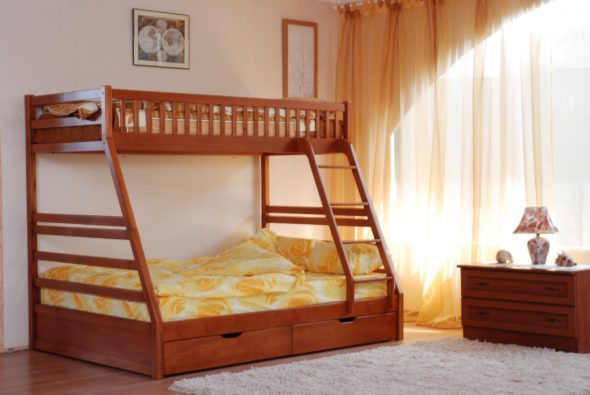
- Chipboard. Wood-based material made by gluing very fine chips with lignin or paraffin wax. Unlike solid wood, it is less durable but easier to work with and significantly cheaper.
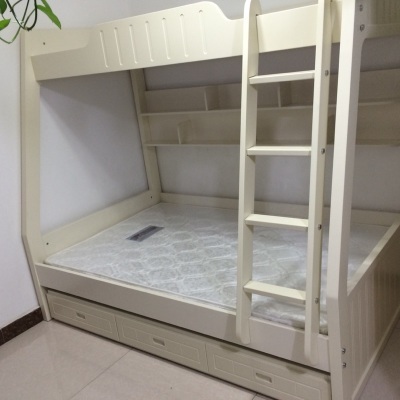
Comfortable bunk bed with additional shelves, made of chipboard 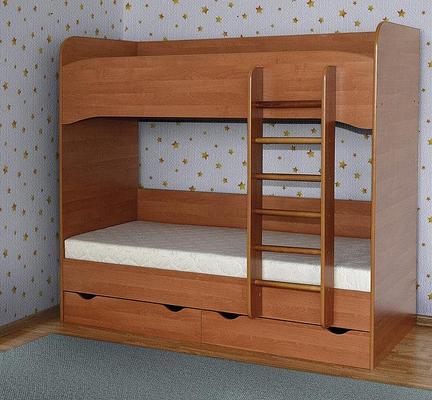
Bed for two children – a budget option from chipboard
We will use pine beams for the base and stairs, chipboard for additional details, plywood for the base under the mattress.
If you want to see more woodworking wizardry — check out our FREE 50 woodworking plans eBook 🙂
Blueprint
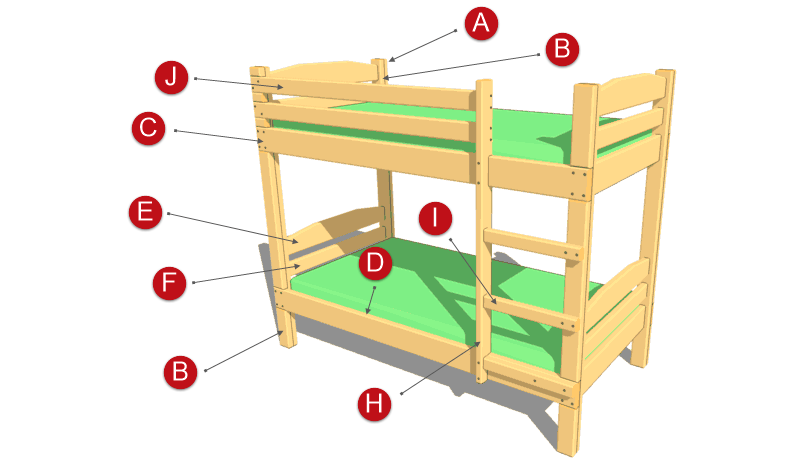
The work is being done in accordance with the blueprint, so the first step is to draw it up. To do this, we take measurements of the room and determine what the length, width, and height of the bed should be. Then we calculate these parameters. Also, figure out how big the ladder should be.
| # | Quantity | Thickness, mm. | Width, mm. | Length, mm. | Part name |
|---|---|---|---|---|---|
| A | 4 | 38 | 76 | 1730 | Head/foot main post (Bed-legs ) |
| B | 4 | 38 | 76 | 1730 | Outer post cut to sizes |
| C | 4 | 38 | 140 | 2030 | Sides |
| D | 4 | 32 | 44 | 1850 | Slat support batten |
| E | 8 | 20 | 90 | 914 | Head/foot top & bottom |
| F | 4 | 20 | 90 | 914 | Head/foot center |
| G | 12 | 20 | 79 | 1000 | Slats |
| H | 1 | 20 | 90 | 1510 | Ladder sides |
| I | 3 | 20 | 64 | 482 | Ladder rungs |
| J | 2 | 20 | 90 | 1800 | Side-bars – cut to fit |
The table consists of several parts. In the first, the parameters of the general design are indicated with a note of the required materials. The second part is devoted to the assembly of individual parts (you can specify their dimensions here). In the third part, the order of installation of the general structure is indicated. It is also worth indicating the order of work, breaking them into points. This will give you a blueprint combined with an action plan.
Prepare the parts
Then, in accordance with the blueprint, we prepare the necessary parts.
We will need:
- 5 pine beams corresponding to the height of the bed (4 for the support parts, 1 for the ladder);
- 4 pine beams cut to the length of the bed (for the base under the mattress);
- 4 beams cut to the width of the bed (also for the base box);
- pine beams for stairs (the amount is calculated in accordance with the height of the bed and the size between the steps);
- boards for the base under the mattress;
- 2 chipboard cut to length (for side strips);
- 2 chipboard cut to the length from the support beam to the beam that serves as a support for the stairs;
- 4 chipboards cut to the width (also for sides);
Bars (aka beams) and chipboards are usually sold in certain sizes (1x1m; 2x1m; 2×1.8m, etc.), so we will have to cut the materials according to our measurements. After trimming, they must be processed with sandpaper or a sander. Chipboard cuts are covered with thermal tape.
So, all the necessary parts are ready, now all that remains is to assemble the individual parts and then assemble those into a single final structure.
If you want to see more woodworking wizardry — check out our FREE 50 woodworking plans eBook 🙂
Bunk bed assembly process
Let’s start with the base. We take the bars prepared for the racks and for the frame. In the bars for the racks, we cut them down with a jigsaw, take the bars along the length of the bed, insert them into these holes, and fasten them with Parker-screws.

Next, we attach the corners to this joint, and to them with Parker-screws, the transverse beams, which, on the other hand, in turn, are fixed with the same corners to the other rack. The result is the back and side panels.
Now we make the front one. We attach the beams for the frame in the same way. It turned out two boxes on a support.

Now we add one more support – for the stairs. We make cuts in the transverse lower and upper beam, and insert a vertical beam into them, fix it.

Make a ladder. Attach stair steps to the bearing beams. They can also be inserted into the base, or fixed from the end with Parker-screws.
If you want to see more woodworking wizardry — check out our FREE 50 woodworking plans eBook 🙂

Now, inside both boxes, screw the boards on which the mattress is laid with Parker-screws.


Assemble the sides by attaching the appropriate size chipboard to the base.
And, our double decker bed is almost ready! All that remains is to add a few final touches.
If you want to see more woodworking wizardry — check out our FREE 50 woodworking plans eBook 🙂
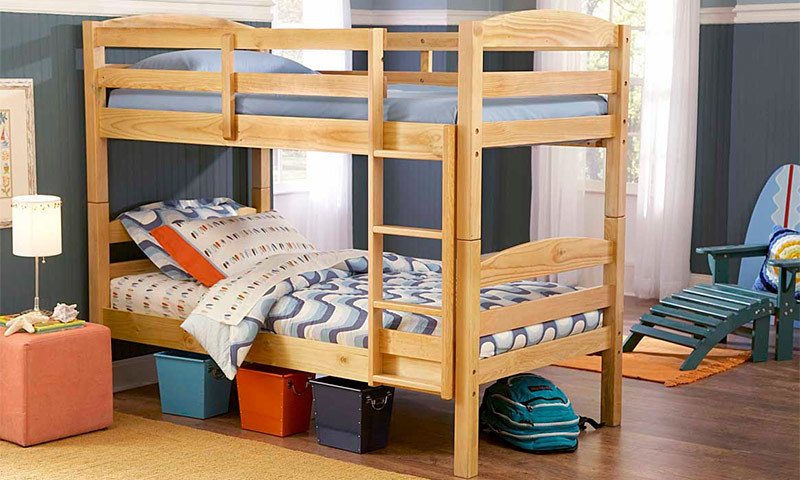
The last step is decorating
If you intend to make a complex decor, it must be thought out in advance and included in the plan, and blueprint. Things like scorching and carving can affect the course of some items, so they should be included in the plan in advance. But when the decor involves painting or pasting with decorative materials, this can be done at the very end.
We made a bunk bed from natural wood, so we will only cover it with varnish. This move is the best option, as the varnish will only emphasize the natural beauty of the wood. But if you want to make the room bright, paint the bed a bright color. It is also a good option to paint the wood white or another neutral color and apply interesting patterns. You can do this with brushes. And if your artistic skills are poor, use stencils. It all depends on your imagination!
Let’s summarize our bunk bed building journey
If you want to see more woodworking wizardry — check out our FREE 50 woodworking plans eBook 🙂
How to make a DIY bunk bed – Steps (Summary)
-
Choosing material
Solid wood beds are famous for their naturalness and durability. And chipboard is less durable but easier to work with and significantly cheaper
-
Drafting a blueprint
The work is being done in accordance with the blueprint, so the first step is to draw it up. To do this, we take measurements of the room and determine what the length, width, and height of the bed should be.
-
Buying and cutting components
Beams and chipboards are usually sold in certain sizes (1x1m; 2x1m; 2×1.8m, etc.), so we will have to cut the materials according to our measurements. After trimming, they must be processed with sandpaper or a sander. Chipboard cuts are covered with thermal tape.
-
Assembling the base
We take the bars prepared for the racks and for the frame. In the bars for the racks, we cut them down with a jigsaw, take the bars along the length of the bed, insert them into these holes, and fasten them with Parker-screws.
-
Assembling Bunk-bed headboard and footboard
The result is the front, back and side panels.
-
Building a ladder
Attach stair steps to the bearing beams.
-
Final assembly
Assemble the sides by attaching the appropriate size chipboard to the base.
-
Decoration and varnishing
If you intend to make a complex decor, it must be thought out in advance and included in the plan, and blueprint. It all depends on your imagination!
-
Your DIY bunk-bed is ready!
You are all done! Congrats! 🙂
As you can see, building a bed with your own hands, even a bunk bed, is not so difficult after all. Therefore, do not hesitate, and feel free to get down to business. And our advice and the presented step-by-step instructions will become a good curator in this matter.
Do not forget to explain to children the rules for using a two-tier structure in order to avoid injury.
If you want to see more woodworking wizardry — check out our FREE 50 woodworking plans eBook 🙂
P.S. Bonus ideas for building DIY bunk beds for your kids and using them in the interior of your house or apartment:
If you want to see more woodworking wizardry — check out our FREE 50 woodworking plans eBook 🙂

